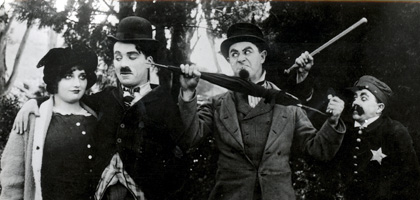Primary navigation
bfi links

For Between Showers we were fortunate that the National Archive held an original Keystone print of nearly 800 feetThis had not suffered too much from shortening within shots and the splices between shots, distinctive to Keystone and printed through from the original negative, confirm that it represents the sequence of shots as it was on release in February 1914. There were no main or end titles but it did contain the original Keystone intertitles.
The other two sources were from the Library of Congress and the Swedish Film Institute. The Library of Congress tinted print was of excellent quality and had been made in 1920 from the original negative.However the National Archive's Keystone print had longer scenes on average.The Swedish material, also tinted, crucially provided much more of the opening shot of Ford Sterling.
It is worth noting regarding the use of tinting, that it is only the reissues of the Keystone films that were tinted. They were originally released in black and white.
In allowing the greatest range of flexibility in choosing where to cut the new negative, that is, to allow cutting between different source material within, as well as between shots, the LoC's nitrate was printed twice to align the position of the frames closely to the Keystone print. The frameline position 'wanders' within the latter. The use of this technique prevented vertical jumps in the position of the frames when cutting within shots between the two copies.
The Keystone print ends early, with Chaplin holding the umbrella after Emma Clifton has angrily walked away. The careful matching of the new negatives allowed the additional material from the LoC print to be cut in mid scene. This cutting in the middle of scene would normally be avoided but the extra effort has resulted in more footage being incorporated from the final scenes. To date, we have not found the film's ending, described in Glenn Mitchell's The Chaplin Encyclopedia , in a full frame 35mm copy.
Matching sections from different sources is a painstaking process. The National Archive's nitrate print varied in contrast and exposure and so it was duplicated twice and the negatives processed to different contrasts. Sometimes it is a case of matching one source to itself!